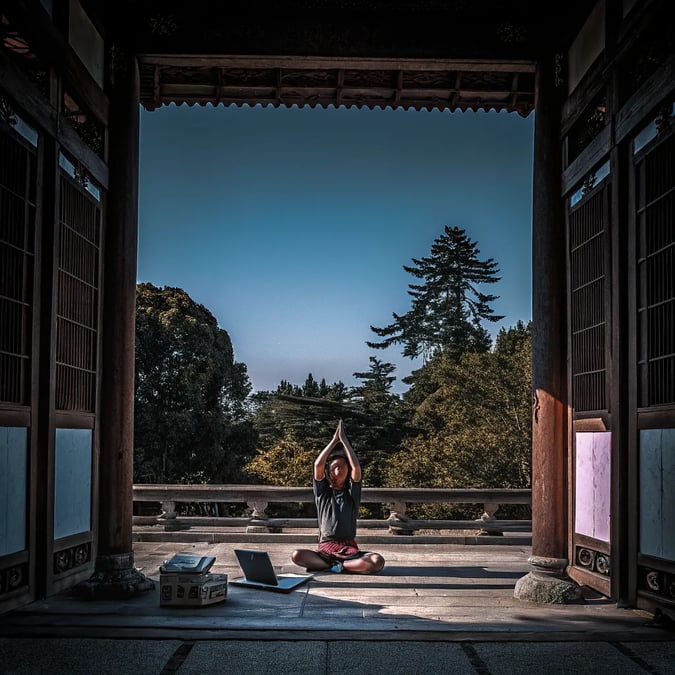
Finding structure when boundaries blur between workdays and weekends is a modern challenge many of us face. Whether you're working from home, have a non-traditional schedule, or simply struggle with maintaining routines, that "endless weekend" feeling can leave you simultaneously overwhelmed and unproductive.
When Time Loses Its Structure
Remember when weekends had a special feeling? They were distinct breaks from the workweek—time to rest, socialize, and recharge. But for many of us, that clear division has faded. A 2021 Reddit thread in r/Adulting captured this sentiment perfectly, with hundreds of users expressing frustration about feeling like "there's not enough time in the day" despite technically having the hours available.
This time-boundary erosion happens for various reasons:
- Remote work blurring the lines between home and office
- Flexible schedules that don't follow traditional Monday-Friday patterns
- Retirement or career transitions removing external structure
- Parenting responsibilities that don't respect weekday/weekend boundaries

As one exhausted parent shared on Reddit, "By the time I get off, I'm exhausted and just want to relax and spend time with my family, but I feel guilty about not making time for exercise or personal hobbies."
This constant balancing act creates what some therapists call "continuous partial attention" - we're never fully present in work or rest, leaving us perpetually unsatisfied with both.
The Psychological Impact of Boundary-less Time
When every day feels the same, several psychological effects typically emerge:
Decision Fatigue: Without the external structure of defined weekdays and weekends, you're forced to decide what each day should include. This constant decision-making drains mental energy.
Motivation Challenges: The brain responds to novelty and contrast. When days blend together, motivation naturally decreases as everything feels like an endless loop.

Identity Confusion: We often define ourselves partly through how we spend our time. When boundaries blur, our sense of identity can weaken.
Dr. Lisa Orbé-Austin, a licensed psychologist specializing in work-life balance, notes that "humans naturally seek rhythm and contrast in their lives. Without clear distinctions between work time and personal time, we often experience increased anxiety and decreased satisfaction in both areas."
Creating Your Own Time Boundaries
Since external time structures have diminished, the solution lies in creating your own intentional boundaries. Here's how to start:
1. Establish Personal "Weekday" Rituals
Even if your actual schedule varies, designate certain days as your personal "weekdays" with specific rituals that signal "productivity mode":
- Create a morning routine that mentally prepares you for focused work
- Dress differently on your designated productive days
- Set up your environment to support concentration (clear desk, specific music)
- Plan meals that support sustained energy rather than comfort or celebration
One working parent shared on a productivity forum: "I wear 'real clothes' on my work days even though I'm at home. The simple act of changing out of loungewear signals to my brain it's not weekend mode."
2. Design Deliberate "Weekend" Experiences
Similarly, designate specific days or time blocks as your personal "weekends" with distinctive qualities:
- Plan activities you genuinely look forward to
- Create spatial changes (different rooms, locations, or environments)
- Establish tech boundaries that differ from your "weekday" rules
- Include social connections that feel refreshing
The key is creating contrast. Your brain responds to differences, not absolute rules about which day is which.
The 3-3-1 Method for Balanced Weeks
One practical approach is the 3-3-1 method for structuring your week, regardless of which actual days serve which purpose:
3 Productive Days: Dedicate three days primarily to work, responsibilities, and forward momentum on projects.
3 Balanced Days: Allocate three days to a mix of responsibilities and enjoyment, with clear boundaries between the two.
1 Freedom Day: Reserve one day with minimal structure—a true "weekend feeling" day where spontaneity rules.
This framework provides rhythm without rigid adherence to traditional weekday/weekend divisions. It can be adjusted to fit irregular work schedules or family needs.
As one Reddit user who implemented a similar approach shared: "I stopped trying to make Saturday and Sunday my only free time. Instead, I take Wednesday as my 'weekend' day, which gives me something to look forward to mid-week and breaks up the monotony."
What About Family Responsibilities?
Parents face unique challenges in creating time boundaries, often experiencing what therapists call "Depleted Mother/Parent Syndrome." As described on Therapy Beyond the Couch, this condition leaves parents feeling like they're fighting "a losing battle" with time.
For those with family responsibilities, consider:
- Micro-boundaries: Even 15-30 minute periods of protected time can provide psychological relief
- Tag-team approaches: Coordinate with partners or support networks for coverage
- Integration strategies: Find ways to include children in activities that refresh you
- Lower perfection standards: Accept "good enough" in some areas to create space in others
One mother shared her solution: "I get up 45 minutes before my kids to exercise and have coffee in silence. It's not a full 'me day,' but that small boundary helps me feel human."
The Guilt Question: When You Feel You Should Always Be Productive
Many people struggle with guilt when they're not being productive, especially when working from home or having flexible schedules. This stems from what psychologists call "productivity anxiety"—the feeling that we should always be accomplishing something.
How to Address Productivity Guilt
Redefine productivity: Expand your definition to include rest, relationship-building, and activities that nurture wellbeing.
Schedule downtime: Literally put rest periods on your calendar as appointments with yourself.
Track energy, not just time: Notice when you're most energetic and align important tasks with those periods.
Create completion rituals: Develop specific actions that signal "work is done" even if you could technically do more.
As career coach Alison Green of Ask a Manager notes, "Setting boundaries isn't selfish—it's what makes sustainable productivity possible in the long run."
What If I Hate My Current Situation?
Sometimes the challenge isn't just about finding balance but dealing with a job or situation you actively dislike. Career Shifters describes this feeling vividly: "You get up every day and force yourself into your commute. You walk into the office and you feel heavy and tired."
If you're in a situation you can't immediately change:
- Create meaningful contrasts within your current reality
- Protect small joys with boundaries
- Develop rituals that separate disliked activities from the rest of your life
- Find one aspect of your current situation to genuinely engage with
Even in difficult circumstances, creating psychological boundaries between different parts of your life can provide relief while you work toward larger changes.
The Practical Week: A Template for Finding Balance
Here's a practical template for creating structure when traditional weekday/weekend boundaries don't apply:
Morning Anchors
Choose 2-3 consistent morning activities that signal what kind of day it is:
- Productive day anchors (example: early alarm, exercise, planning session)
- Balanced day anchors (example: moderate wake time, brief planning, light exercise)
- Free day anchors (example: natural waking, slow breakfast, no planning)
Transition Rituals
Create clear beginnings and endings for different types of activities:
- Work-to-personal transition (example: changing clothes, short walk, different music)
- Personal-to-social transition (example: specific preparation routine, mental reset)
- Evening wind-down (example: consistent steps that signal day's end)
Weekly Planning
Dedicate 30 minutes each week to intentionally design your upcoming days:
- Designate which days will serve which purposes
- Identify one special activity to anticipate
- Schedule at least one social connection
- Plan one self-care activity that requires preparation
Finding Your Personal Balance
The perfect balance isn't universal—it's personal. Some thrive with more structure, others with more flexibility. The key is intentional design rather than drifting through sameness.
As you experiment with creating your own time boundaries, pay attention to:
- Energy levels throughout different approaches
- Sleep quality as an indicator of balance
- Relationship satisfaction
- Sense of accomplishment and presence
Adjust your approach based on these indicators rather than rigid rules about how time "should" be structured.
Remember that finding balance isn't a one-time achievement but an ongoing practice. As your circumstances change, so will your ideal balance between structure and flexibility.
How Do I Know If My Approach Is Working?
A common question is how to evaluate if your time-balancing strategy is effective. Unlike traditional productivity metrics, balance requires different measurements.
Consider these indicators of successful balance:
- You can name something specific you're looking forward to each week
- You experience both productivity satisfaction and true relaxation
- You're present during activities rather than mentally elsewhere
- You sleep well most nights
- Transitions between activities feel manageable rather than jarring
- You have energy for both responsibilities and relationships
If these indicators are missing, it's time to adjust your approach—not necessarily work harder at the current one.
As one Reddit user wisely noted, "I realized I was trying to fit too many things into each day instead of spreading them across the week. Now I have themed days, and while I do less each day, I accomplish more overall and actually enjoy the process."
Finding balance when every day feels the same isn't about recreating traditional weekday/weekend divisions. It's about creating intentional contrast, meaningful transitions, and personal rhythms that work for your unique circumstances. With thoughtful boundaries and regular adjustments, you can create a week that includes both productivity and joy—even when the calendar doesn't dictate which is which.
References and Resources
Tags

About Clara Vanderbeek the Author
Clara Vanderbeek is a consummate wanderer and slow-travel aficionado, dedicated to crafting thoughtful travel guides that encourage travelers to savor every moment and delve deeper into the heart of each destination. Her expertise lies in uncovering hidden gems and local cultures, fostering genuine connections with the places she explores.
Recommended Articles
Retirement Planning Essentials Every American Should Know
Learn essential retirement planning tips for a secure financial future, including types of plans and savings strategies every American should know.
Medicare Drug List Updates for 2026 Are Out
Discover the key Medicare drug coverage updates for 2026, including cost caps and price negotiation programs for better healthcare options.
Which iPhone Color Fits Your Style Best
In 2025, Apple tantalizes with its latest iPhone colors, each more chic and expressive than the last—think deep Titanium Blue, vibrant Product RED, and sophisticated Desert Sand. Whether your style leans toward muted sophistication, bold statements, or earthy tones, this guide reveals how your iPhone hue can harmonize with your wardrobe and lifestyle, elevating your personal tech as both a tool and statement piece. Dive in to discover which shade will perfectly reflect your personality and make you eager to flaunt your device.
Why More Adults Are Switching to Safety Footwear
In recent years, safety footwear has transcended its construction site origins, becoming a fashionable and practical choice for adults across various demographics seeking both comfort and protection in their daily wardrobes. With sleek designs, versatile features like non-slip soles and breathable materials, and a growing awareness of foot health, these modern safety shoes are not only reducing fall risks but also proving that style and functionality can go hand in hand. Discover how these shoes are revolutionizing everyday fashion and why more people are making the switch.
See the New iPhone Colors Everyone’s Talking About
Unveiling the dazzling iPhone 2025 color lineup, Apple has stunned audiences with striking hues like deep emerald, Alpine Blue, and Desert Titanium, making waves among tech enthusiasts and setting a new benchmark for smartphone aesthetics. Discover how these colors not only enhance the iPhone's premium feel but also influence its resale value, offering a fresh perspective on choosing the perfect shade for your next device.




